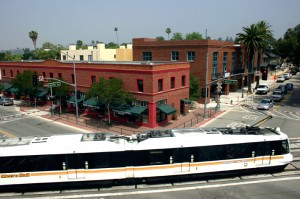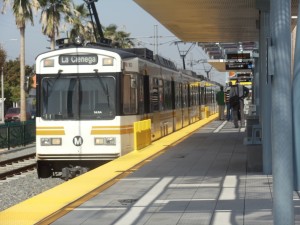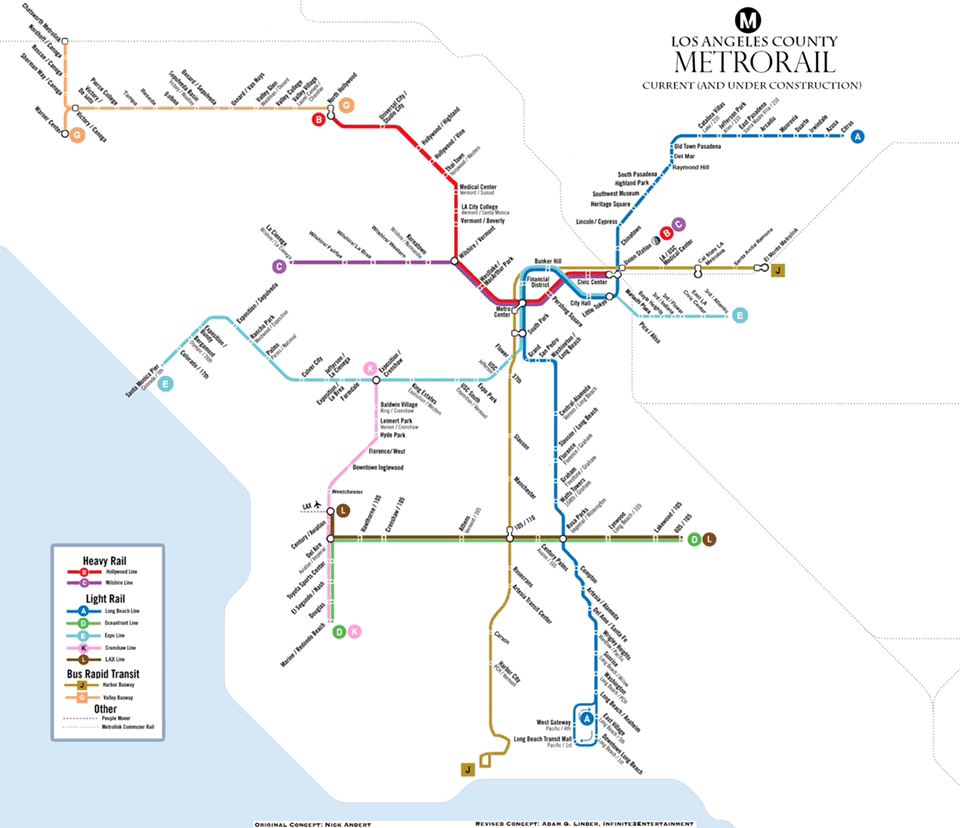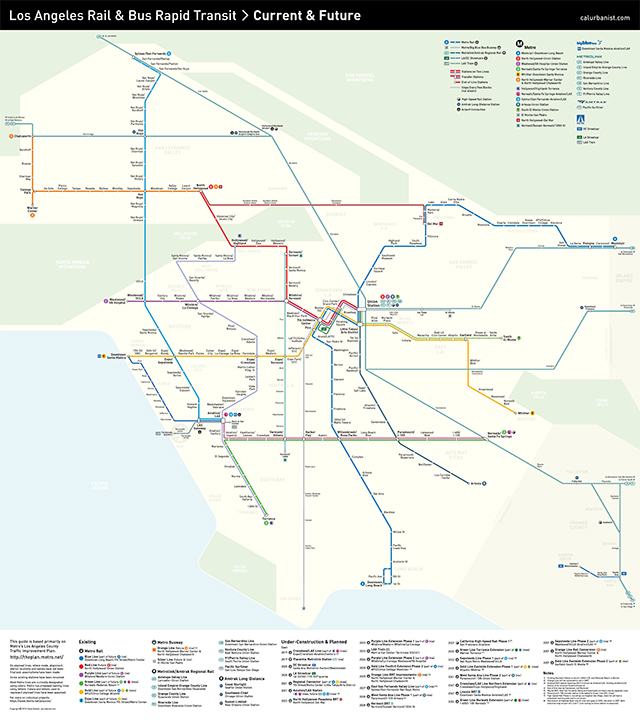 Measure M is one of the most promising ballot measures to pass in Los Angeles County in recent years. It offers $120 billion in long-term sales tax revenue to fund transportation projects — the kind of money that can help transform mobility in the region.
Measure M is one of the most promising ballot measures to pass in Los Angeles County in recent years. It offers $120 billion in long-term sales tax revenue to fund transportation projects — the kind of money that can help transform mobility in the region.
But the money brings perils, too, which I describe in a Los Angeles Times op-ed today:
If history is any guide, L.A. transit leaders have a habit of prioritizing politically expedient projects over ones that would benefit more riders. Faced with NIMBY opposition, our leaders too often cave.
Just look at the Expo Line from downtown L.A. to Santa Monica, a route that remains hampered by slow travel times after transit leaders failed to give the train priority over automobiles along city streets. Additionally, failure to push through with adequate development projects along the route denied this expensive rail technology an easy ridership boost.
Will transportation leaders similarly compromise away good Measure M projects until they go bad?
To answer this question, it’s important to understand what a “good” project entails. Cost-effectiveness — using the fewest dollars to move the most people the greatest distance — is key. Projects should attract maximal ridership, based on existing population, job density and service quality. Potential ridership, based on the feasibility of building more housing, retail and offices within walking distance of stations, is another crucial determinant. (The failure of the anti-growth Measure S in the recent L.A. election adds even more weight to this component.) Finally, projects should maximize reductions in overall driving miles, air pollution and greenhouse gas emissions.
The piece details some immediate tests facing Metro leaders and offers recommendations to ensure that they make smart decisions. The long-term future of LA in many ways will be determined by these short-term actions.
 Yes, there’s a lot happening today in the national election. Lost in the shuffle though are three big initiatives before some California voters that could have a big impact on the state’s transit and development future.
Yes, there’s a lot happening today in the national election. Lost in the shuffle though are three big initiatives before some California voters that could have a big impact on the state’s transit and development future.
- Measure RR to restore BART: this is an unusual transit measure because it’s one of the first I’ve seen that makes no promises about expanding transit service. Instead, it seeks to issue bonds solely for maintenance of the aging San Francisco Bay Area Rapid Transit (BART) system. The bond issue will require two-thirds approval, which is a high hurdle. But failure to pass means that BART will continue to have reliability issues and won’t be able to increase train frequencies to meet growing ridership. It’s a nod to the reality of what happens to rail lines with too much neglect, as Washington DC is now experiencing.
- Measure M to boost transit (and transportation) in Los Angeles: the County of Los Angeles is going back to the voters for another transportation sales tax measure. If it passes, without a sunset date like 2008’s Measure R, it will solidify Los Angeles as a national leader in building rail transit and will transform the city for the rest of this century. That will be a total and major shift for the region that once sold the image of car-oriented suburbia to the world.
- Santa Monica’s LV measure to prevent new housing: this is more of a bellwether initiative that could be a harbinger of a backlash against pro-housing policies throughout the state. Santa Monica is a wealthy coastal community that recently got a multibillion, taxpayer-funded rail line delivered to its shores. But homeowners there have already helped squash one big development project next to a rail station, and this initiative would prevent any substantial new housing from being built, under the guise of direct democracy. Its effect would be to depress transit ridership on the new rail line, greatly escalate home prices and rents by artificially restricting supply, and continue the trend of core urban residents forcing new arrivals to the sprawl periphery in search of affordable homes, far from well-paying jobs. While Santa Monica is only one community, the success of the initiative could be a prelude to further anti-housing victories in greater Los Angeles and the state.
So while the nation will be focused on bigger elections, these three will in their own way have a significant effect on the future of California’s cities, environment and economy. Another reason to stay tuned!
 The history of transit in Los Angeles County has too often been about parochial infighting and city feuding. It has thwarted many regional efforts to address the collective traffic and land use challenges in the region.
The history of transit in Los Angeles County has too often been about parochial infighting and city feuding. It has thwarted many regional efforts to address the collective traffic and land use challenges in the region.
This November, the story may re-appear, with southern L.A. County leaders threatening to torpedo the November sales tax measure for transportation, Measure M.
The Los Angeles Times is running my op-ed on the subject today. Here’s a snippet in response to south county residents’ concerns that they’re not getting enough out of the measure:
Residents of southern L.A. County are of course part of the greater region of Los Angeles — whether they work, visit, or shop in other parts of the county. Regional travel data from 2014 show that almost half of all peak period commutes from the Gateway and South Bay regions are bound for other parts of the county. These residents will benefit from mobility improvements throughout L.A. — not just the projects in their backyard. They’ll certainly stand to gain from some of the proposed signature projects, such as rail access to LAX and multiple countywide bus rapid transit lines.
So far the polling on the measure is looking pretty good, but with the two-thirds voter requirement, it will be an uphill battle. And that means that the measure could live or die by what voters in the southern part of the county decide on Election Day.
Laura Nelson reports in the Los Angeles Times on opposition to the November sales tax measure for transit (with some quotes from yours truly), localized in the southern part of the county:
But in the southern half of the county, where about one-third of likely voters live, some officials have refused to endorse the measure, questioning whether their constituents would see their fair share of projects.
Leaders in Torrance, Signal Hill and Carson have slammed Metro for not allocating more funds for local transportation needs, including street repairs. Others have groused that the $891-million Green Line extension from Redondo Beach to Torrance, a project discussed for years, is not slated to break ground for a decade.
Voters are free to choose as they like, but it’s hard to be sympathetic to these southern county leaders. As the article points out, they’ll receive plenty of return on the tax in terms of local road, transit and highway funds.
But more importantly, residents of southern L.A. county are part of the greater region of Los Angeles, whether they work, visit or shop in other parts of the county. They certainly benefit from an urban economy that functions with mobility for all. So it seems short-sighted to try to torpedo a rare chance at achieving the two-thirds voter threshold this November, just because a few of their local, desired projects aren’t rising to the top of the to-do list.
Ultimately, I’d like to see a statewide ballot measure to lower this threshold to at least 55%, so regions like Los Angeles aren’t held hostage to the whims of the few and forced to devise politically motivated transportation plans. But in the meantime, transit proponents are stuck trying either to placate opponents like these or hope that they can weather the storm come November.
Either way, the vote is likely to be close, evidently with little help from some local leaders.
With a region as big as Los Angeles, it can be tough to visualize how new transit projects will fit into the landscape. And now that Measure M is on the ballot this November, a whole host of new projects are potentially at stake to add to the mix.
To make it easy for voters to visualize, amateur map-maker Adam Linder developed his own blinking GIF map, which has caught on with outlets like Curbed LA:
Adam describes why he developed the map in this interview with KPCC radio last week. Apparently my book Railtown was an inspiration for him to get into this issue, which is gratifying to hear. His map follows another one put together by a transportation consultant earlier this summer.
As the region contemplates Measure M this fall, grassroots efforts like these may end up making a big difference in swaying voters.
What started with Proposition A in 1980, continued with Proposition C in 1990, and then bolstered with Measure R in 2008, will now be tested once again officially as Measure M in November. I’m talking of course about Los Angeles rail transit plans, which once again hinge on another voter-approved sales tax measure.
The measure promises a host of new transit plans for the region, as illustrated with this map as a side project from a Nelson/Nygaard employee:
A few notable things stand out about this measure. First, there is no sunset date, which is a departure from Measure R’s 30-year limit. The justification is that the measure includes operating funds for transit, which address a need that doesn’t sunset.
Second, the new projects cover some vital links in the region, most prominently a public-private toll road and rail tunnel connection from the Westside to the Valley underneath the Sepulveda Pass. It also includes rapid bus down the high transit-usage Vermont Avenue and Lincoln Boulevard along the coast and connections to the eastern part of the county (including the gap between the Green Line in Norwalk and the Metrolink station).
There will be a battle royale to try to surmount the two-thirds voter approval hurdle this November, and the plan clearly contains a lot for every part of the county, including some unfortunate projects (the “High Desert Corridor” freeway stands out as particularly egregious). But it’s hard to blame Metro for trying again, given the success in 2008 and near-miss in 2012 with Measure J, along with the scale of the need.





